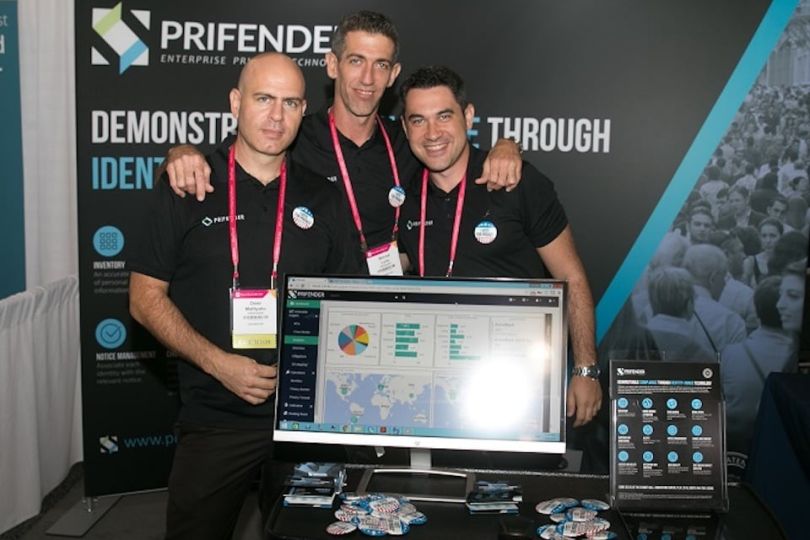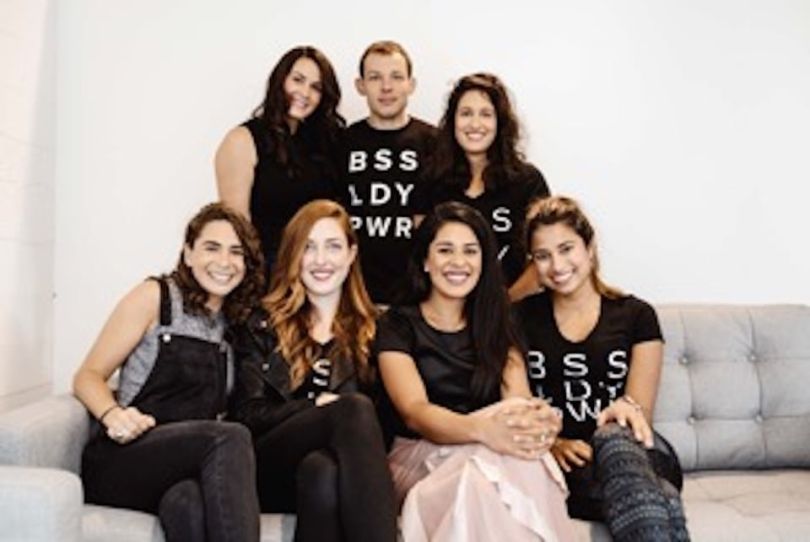Moments of pure inspiration can be rare, but ideas that spawn a successful business are even rarer. And if there’s one thing we learned from talking to the up-and-coming founders featured below, it’s that industry-changing ideas don't just appear like lightbulbs.
Rather, they grow like seeds, feeding on a fledgling founder's life and business experience, until they pop through the topsoil (heck, let's run this overwrought metaphor to its logical conclusion) and start reaching for the sky.

When Prifender co-founder and CEO Nimrod Luria (pictured above, center) sold his first business — a cloud-based website security firm named Sentrix — in 2015, he was already thinking about his next company. Founded in Bellevue in 2015, Prifender uses artificial intelligence to discover and map personal information across networks and systems, allowing organizations to monitor their data and demonstrate accountability and compliance, and only recently raised $5 million in its first round of funding.
If you were going to explain your business to your technologically illiterate grandparents, how would you describe it to them?
I would tell them it is like a hound dog that is getting some data to sniff, and then it can instantly find the requested data in dozens or even hundreds of systems, sifting through an endless pile of text.
Part of my research involved personally contacting large enterprises and requesting the data I was entitled to receive. To this day, I have never heard from them.”
When did you have your “lightbulb” moment — the moment where the idea for Prifender came to you?
After selling my previous company in 2015, I wanted my next company to be like a “big whale alone in a blue ocean.” Since I already had experience with the security industry, I wasn't sure it was going to be my first choice. But as I began learning more and more about privacy legislation adaptations — like safe harbor and GDPR — I quickly realized that privacy, of all other industries, has huge potential. I began to ask the same question again and again: “How can companies show all the data they have on any certain individual, instantly?” Part of my research involved personally contacting large enterprises and requesting the data I was entitled to receive. To this day, I have never heard from them.
How did you go about turning that idea into a business?
We started working in a garage, in a very lean mode, and within a few months we raised some seed funding turned the idea into a business by 2016.

Armoire aims to apply principles of the sharing economy to women’s clothing — a multi trillion-dollar industry. Co-founder Ambika Singh says members are welcome to purchase items if they really fall in love with them, but Armoire encourages members to live “more lightly” and share the things they love with other members of the community.
If you were going to explain your business to your technologically illiterate grandparents, how would you describe it to them?
We use a personalization algorithm that understands a woman’s individual preferences and builds a “dream closet” of 15 to 30 items. It’s constantly updated to be applicable to her life in that moment. So if she’s traveling to Hawaii or has a big board meeting or is on a break at home with the kids, the virtual closet adapts to match her lifestyle.
We’ve always had a very sales-focused mentality — we’re reacting to what the consumer wants rather than just coming up with something and hoping people will buy it.”
When did you have your “lightbulb” moment — the moment where the idea for Armoire came to you?
I was in Boston at the time; I was a grad student so I still had a residence here in Seattle. I had several full closets between all the different places I lived, and I felt bad about it. Items were underutilized, and yet I still found myself scrolling through the internet looking at new things. It seemed crazy from a time management perspective, as well as monetarily and environmentally.
I spent about a year working at Rover and saw how we can share things in a way that increases efficiency from both sides, so that led me toward rentals.
How did you go about turning that idea into a business?
I started by talking to my friends and my community, trying to see if this was a problem that just I thought was interesting, or if it is something that a large population would be interested in. Then we had a more structured survey, where we interviewed 500 women. We got into the MIT accelerator, and came out on the other side with some real revenue. That was really exciting. We’ve always had a very sales-focused mentality — we’re reacting to what the consumer wants rather than just coming up with something and hoping people will buy it.

Dr. Amit Dhingra founded horticulture startup Phytelligence in 2011, and in addition to a Seattle headquarters, the company has facilities in Burien and Portland, Oregon. They also recently began operations in India. In addition to his role as chief science officer at Phytelligence, Dhingra is a professor of genomics and biotechnology in the department of horticulture at Washington State University’s College of Agricultural, Human and Natural Resource Sciences.
If you were going to explain the business to your technologically illiterate grandparents, how would you describe it to them?
Phytelligence grows food crops using a soil-free process, which means the plants are delivered without any harmful bacteria or fungi in their roots. We develop crops that are disease-free and can grow at a faster rate than plants grown by traditional nurseries, compressing three or four years of growth into one year.
We develop crops that are disease-free and can grow at a faster rate than plants grown by traditional nurseries, compressing three or four years of growth into one year.”
When did you have your “lightbulb” moment — the moment where the idea for Phytelligence came to you?
More than a “lightbulb” moment, it was the “tree bearing fruit” moment. The traditional process of multiplying crops involves digging the root out of the ground prior to storage or delivery, which damages the roots and exposes the plant to soil-borne pathogens. If there is severe cold or heat during the growing season, plants can have a mortality rate of 10 to 40 percent.
In summary, the process was developed based on the industry’s need rather than a “lightbulb” going on. Sometimes ideas developed through a “lightbulb” moment can take years to find a market.
How did you go about turning your idea into a business?
Learning about these pain points and goaded by colleagues, I began to experiment in my lab. We developed the plants through our soil-free process, gave away samples to the industry, incorporated their feedback and came up with the product.
Bill Flora’s experience design firm, Tectonic, has worked with Amazon, HBO, Samsung, Skype, Bing, Cisco and Beats Music. Before he co-founded Tectonic, Flora was at Microsoft for over 20 years, working on the Encarta Encyclopedia, Xbox, Windows Media Center and Zune. Tectonic was acquired by Blink earlier this year, and Flora retains a role as chief creative officer.
If you were going to explain the business to your technologically illiterate grandparents, how would you describe it to them?
We help companies determine what their digital products should be, how they should look and feel.
We help companies determine what their digital products should be, how they should look and feel.”
When did you have your “lightbulb” moment — the moment where the idea for Tectonic came to you?
I went right from design school into Microsoft, and after 20 years there I was ready to do something different. Of all the products I worked on for Microsoft over the years, one of the activities that had the most impact in the company, and also happened to be the most rewarding, was designing the company’s “Metro” design language. It applied “flat” design principles and was used all across the company.
But that sort of design activity only took up about 10 percent of my time, and over time it began to click that I would rather do that part of the job for 90 percent of my day, rather than 10 percent.
How did you go about turning your idea into a business?
Two colleagues left Microsoft around the same time as me, and we three were the powerhouse team who started Tectonic. We felt we had the reputation, from the publicity that came out of the Metro story, that we could parlay that into connecting with other clients.







